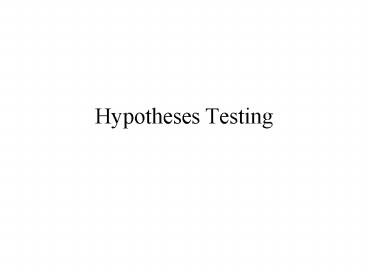Hypotheses Testing - PowerPoint PPT Presentation
1 / 22
Title:
Hypotheses Testing
Description:
We know that on average mouse tail is 5 cm long. We have a group of 10 mice, and give to each of them a dose of vitamin X ... vitamin X makes mouse tail longer ... – PowerPoint PPT presentation
Number of Views:21
Avg rating:3.0/5.0
Title: Hypotheses Testing
1
Hypotheses Testing
2
Example 1
- We have tossed a coin 50 times and we got
- k 19 heads
- Should we accept/reject the hypothesis that
- p 0.5
- (the coin is fair)
3
Null versus Alternative
- Null hypothesis (H0) p 0.5
- Alternative hypothesis (H1) p ? 0.5
4
EXPERIMENT
p(k)
95
k
5
Experiment
- P k lt 18 or k gt 32 lt
0.05 - If k lt 18 or k gt 32 then an
event - happened with probability lt 0.5
- Improbable enough to REJECT the hypothesis H0
6
Test construction
18
32
accept
reject
reject
7
0.975
Cpdf(k)
0.025
k
8
Conclusion
- No premise to reject the hypothesis
9
Example 2
- We have tossed a coin 50 times and we got
- k 10 heads
- Should we accept/reject the hypothesis that
- p 0.5
- (the coin is fair)
10
cpdf(k)
k
11
Significance level
- P k ? 10 or k ? 40 ? 0.000025
- We REJECT the hypothesis H0
- at significance level p 0.000025
12
Remark
- In STATISTICS
- To prove something REJECT the hypothesis that
converse is true
13
Example 3
- We know that on average mouse tail is 5 cm long.
- We have a group of 10 mice, and give to each of
them a dose of vitamin X everyday, from the
birth, for the period of 6 months.
14
We want to prove that vitamin X makes mouse tail
longer
- We measure tail lengths of our group and we get
sample 5.5, 5.6, 4.3, 5.1, 5.2, 6.1, 5.0, 5.2,
5.8, 4.1 - Hypothesis H0 - sample sample from normal
distribution with ? 5cm - Alternative H1 - sample sample from normal
distribution with ? gt 5cm
15
Construction of the test
reject
t
t0.95
Cannot reject
16
We do not population variance, and/or we suspect
that vitamin treatment may change the variance
so we use t distribution
17
?2 test (K. Pearson, 1900)
- To test the hypothesis that a given data
actually come from a population with the proposed
distribution
18
Data
- 0.4319 0.6874 0.5301 0.8774 0.6698
1.1900 0.4360 0.2192 0.5082 - 0.3564 1.2521 0.7744 0.1954 0.3075
0.6193 0.4527 0.1843 2.2617 - 0.4048 2.3923 0.7029 0.9500 0.1074
3.3593 0.2112 0.0237 0.0080 - 0.1897 0.6592 0.5572 1.2336 0.3527
0.9115 0.0326 0.2555 0.7095 - 0.2360 1.0536 0.6569 0.0552 0.3046
1.2388 0.1402 0.3712 1.6093 - 1.2595 0.3991 0.3698 0.7944 0.4425
0.6363 2.5008 2.8841 0.9300 - 3.4827 0.7658 0.3049 1.9015 2.6742
0.3923 0.3974 3.3202 3.2906 - 1.3283 0.4263 2.2836 0.8007 0.3678
0.2654 0.2938 1.9808 0.6311 - 0.6535 0.8325 1.4987 0.3137 0.2862
0.2545 0.5899 0.4713 1.6893 - 0.6375 0.2674 0.0907 1.0383 1.0939
0.1155 1.1676 0.1737 0.0769 - 1.1692 1.1440 2.4005 2.0369 0.3560
1.3249 0.1358 1.3994 1.4138 - 0.0046
Are these data sampled from population with
exponential pdf ?
19
Construction of the ?2 test
p2
p3
p1
p4
20
Construction of the test
reject
?2
?2 0.95
Cannot reject
21
How about
Are these data sampled from population with
exponential pdf ?
- Estimate a
- Use ?2 test
- Remember d.f. K-2
22
Power and significance of the test
Actual situation
decision
probability
1-a
accept
H0 true
Reject error t. I
a significance level
b
Accept error t. II
H0 false
reject
1-b power of the test































